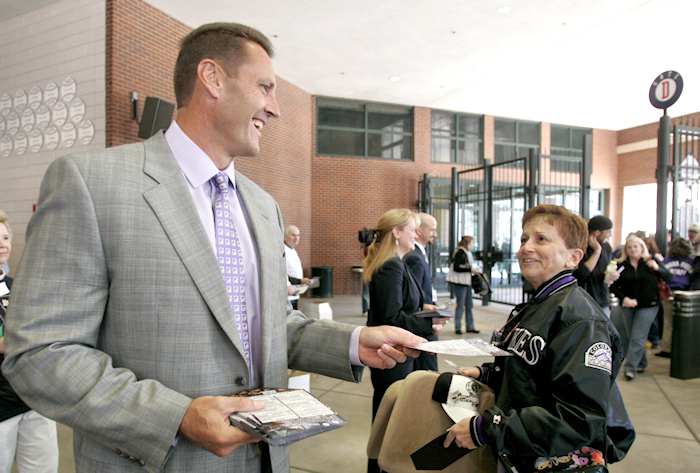
On the occasion of the 10th anniversary of Keli McGregor’s untimely death on April 20, 2010, I penned a profile of the late President of the Colorado Rockies for USA TODAY. The article examined his legacy and looked at exactly why he was so beloved within the Rockies organization and across all of baseball. A shorter version of this appeared in the April 15, 2020 USA TODAY Sports Weekly. Here is the full, unabridged version. (PHOTO ABOVE COURTESY OF THE COLORADO ROCKIES)
Joe Mock
BaseballParks.com
All rights reserved
Rising above its Lower Downtown neighborhood in Denver is an impressive construction project. Comprised of three buildings surrounding an open plaza, it will be the very definition of a “mixed-use” development, with office and retail space, eateries, a hotel, and over 100 condos.
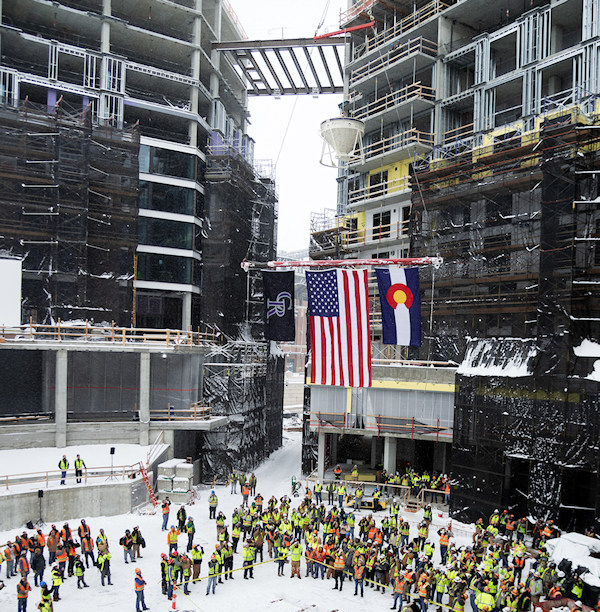 |
| On February 7, 2020, a celebration was held for the “topping off” of the construction of McGregor Square. COURTESY OF THE COLORADO ROCKIES |
The site, across the street from Coors Field, was used as a parking lot for Colorado Rockies games. In fact, the baseball team is acting as the developer for the project. When construction is complete in the first quarter of 2021, “we will manage all of it,” says Dick Monfort, team Owner/Chairman and the driving force behind this project. “You’ll love what we do here. In fact, my wife and I will be living here when it’s done.”
As for what the project should be called, Monfort hired a consultant “who gave us a bunch of names, but I discarded all of them.” Instead, he decided to call the complex McGregor Square, in honor of the Rockies’ President Keli McGregor, who passed away 10 years ago this month.
He explains that the development “is about excellence. It’s about fun. It’s about family. It’s all the things that Keli believed in.”
Why would a front-office employee who passed away a decade ago be honored this way? What made McGregor beloved, both within the Rockies organization and across baseball? The answers come when you study his legacy in three areas: in the sport; in the structures that honor him and reflect his values; and in his family.
Legacy in the sport
After a short stint in the NFL as a tight end, McGregor worked in the athletic departments at the University of Florida and the University of Arkansas. At the latter, observers felt he was being groomed to succeed the legendary Frank Broyles as the Razorbacks’ Athletic Director.
One of his responsibilities was to oversee the design and construction of Bud Walton Arena, hailed as one of the top basketball facilities in the country. His experience on this successful endeavor was very attractive to the Rockies, who were about to embark on the design of Coors Field. The team lured McGregor to Denver in 1993, making him the Senior Director of Operations.
While it was his experience with facilities that was behind the Rockies’ desire to bring him on board, the team discovered that McGregor possessed immense leadership skills. As he rose through the front-office ranks, eventually becoming team president in 2001, he made an impact on everyone around him.
“He cared about everybody,” Monfort recalls. “He cared equally for an usher as for his All Star first baseman or his manager.”
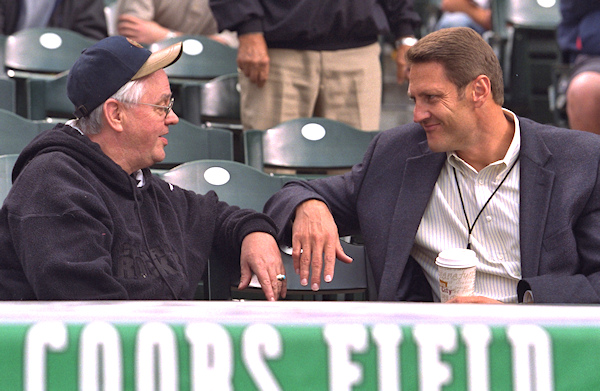 |
| Keli McGregor (right) chats with a season-ticket holder at Coors Field in 2002. COURTESY OF THE COLORADO ROCKIES |
Dave Dunne became the General Manager of the spring-training facility known as Salt River Fields in 2009, while it was still under construction. Today, the sprawling complex near Scottsdale, Arizona is the springtime home of both the Rockies and the Arizona Diamondbacks.
Early in his tenure, he attended a packed reception for the Rockies’ corporate sponsors. Since he didn’t know any of the attendees, he stood by himself. McGregor spotted him from across the ballroom, and immediately brought over players Jason Giambi and Todd Helton.
Dunne recalls that “Keli said to them, ‘Hey guys, I want you to meet Dave, who’s going to be the GM at Salt River.’ As busy as he was, entertaining this entire group, he brought over these two big-name guys to talk to me. Keli wanted everyone to be engaged.
“That showed compassion. He didn’t want anyone to feel like an outsider.”
Similar stories are told by many who served in the Rockies organization.
Clint Hurdle managed the Rockies from 2002 until May 2009, including the franchise’s only World Series appearance in 2007. “Working with Keli was one of the most beneficial relationships I ever had,” he says. “He was the first man outside of my father that took an interest in challenging me to be the best version of me, personally and professionally.
“Keli was a true servant leader. His number-one trait was that everybody mattered.”
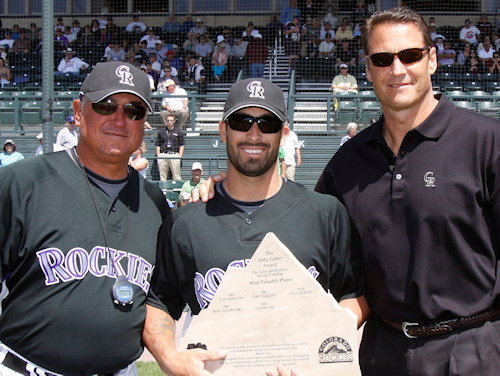 |
| Clint Hurdle (left) and Keli McGregor (right) award Ryan Spilborghs (center) as the team’s Spring Training MVP in 2009. COURTESY OF THE COLORADO ROCKIES |
McGregor wasn’t shy about sharing his convictions. “He had a strong faith,” Hurdle continues. “He was a strong Christian man. He talked about having a blueprint, a personal blueprint for life and a professional blueprint.
“He’s been gone 10 years, but he’s not gone. There are many people walking the earth today that are still motivated by Keli. I’m one of them.”
McGregor’s daughter Taylor tells the story about Ryan Spilborghs, outfielder for the Rockies from 2006 through 2011, and current analyst on the team’s telecasts. His mother was seriously ill, so when Spilborghs was on road trips, McGregor would visit her in the hospital without mentioning it to anyone.
Eventually, the nurses in the hospital told Spilborghs about the visits, so he asked McGregor why he’d kept them a secret. Taylor says that her father told him, “‘I didn’t think I needed to tell you because you’re family. I just felt like I needed to be there.'”
Adds Taylor, “He didn’t want for his visits to be for any reason other than he wanted Ryan’s mom to feel like she was family. He did little things like that all the time.”
Greg Feasel was hired by McGregor in 1995. Initially he ran sales and marketing. Today he is the Rockies’ Chief Operating Officer.
 |
| Keli McGregor with Greg Feasel in September 2009. When they traveled together, they were dubbed The Twin Towers. COURTESY OF THE COLORADO ROCKIES |
Like McGregor, Feasel had a football background – and both were 6’7”. When they traveled together, “people called us the Twin Towers,” he recalls. “We stood out in a crowd.
“We had a great relationship. I consider him a brother.”
Feasel recalls times when he’d be at Rockies spring training in Tucson, and “I’d go into Starbucks, and there he’d be with his Bible study group. His faith and his family were so important.”
McGregor had quite an impact on his owner, too. “I considered Keli as a mentor,” Monfort says. “Usually you don’t pick someone 10 years younger than you to be a mentor, but he taught me a lot of things about business and life. I guess technically Keli worked for me, but it never felt like that.”
Monfort feels that McGregor’s impact extended well beyond the organization he worked for. “He created a way that smaller (market) teams could compete. Yes, he had a great deal to do with the sport of baseball.
“Whenever there was a list of ‘the young and bright people of baseball,’ Keli was on it.”
Derrick Hall, President and CEO of the Arizona Diamondbacks, recalls encountering McGregor at owners meetings and industry gatherings. The two became friends, and when they started spending significant time together as the Diamondbacks and Rockies planned Salt River Fields, “I quickly realized what a special person he was. How real. How genuine. How spiritual.”
Hall adds that he “was someone who was beloved in the entire industry. It’s because of who he was. He was a resource for everyone. He was always there to give advice, give his opinion, his experience.”
Pat Courtney, Chief Communications Officer at Major League Baseball, got to know McGregor when planning began for the 1998 All Star Game at Coors Field. “He led the meetings for it,” recalls Courtney. “He was bigger than life. He was tall, good looking, and he also had presence. He was a natural leader.”
He adds “To me, he represented the next generation of leaders in the sport. He had accomplished so much, and he had a long career ahead of him.”
Regarding the current delay in the start of the season due to COVID-19, Courtney feels that McGregor’s leadership would’ve benefited baseball immensely. “He would have a positive attitude about how we’re going to come out of this. There’s no question about that.”
Hall noted that team presidents are currently conducting frequent calls about the delayed season. “I keep thinking that I wish Keli was a part of these calls. He was a healer, and people really need to be healed right now. He would’ve been one more really strong voice that everyone would’ve listened to.”
Sadly that voice became silent at age 48. On April 20, 2010, he was felled by a rare viral infection that attacked his heart muscle while he was on a business trip in Salt Lake City.
Absolutely devastating
Dunne recalls the last time he was with McGregor. The two were touring the construction site of Salt River in the spring of 2010.
“I remember thinking that he was as big as the McDowell Mountains that you can see from here. He seemed invincible. That was just 10 days before he passed away.”
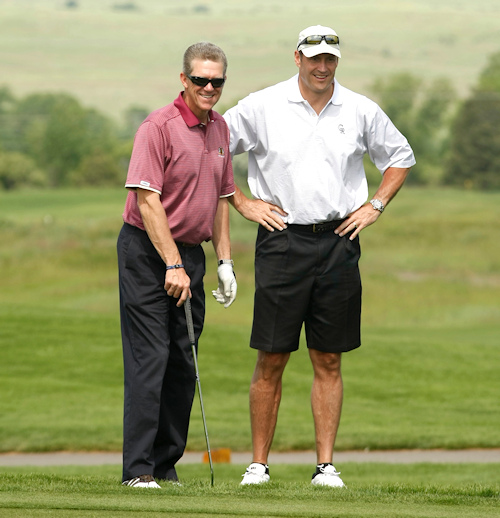 |
| In 2009, Rockies Manager Jim Tracy with Keli McGregor. COURTESY OF THE COLORADO ROCKIES |
Jim Tracy was the Rockies’ manager from 2009 through 2012. “I don’t have words to use about how I felt about him,” he says of his admiration for McGregor. He adds that some leaders “have the innate ability to get you to want to run through a wall for them. It’s a God-given gift, and this man had it.”
In April of 2010, the team was on a road trip in Washington, DC. Tracy was in his hotel room when he received the knee-buckling call about McGregor’s sudden passing. “Thank God I was sitting in a chair, because it would’ve taken me down. There’s no doubt in my mind,” he recalls.
Word of McGregor’s death had started to make the rounds when Tracy addressed the team that afternoon. “He was a 48-year-old man who was in as good a shape or better than the players. Beyond being devastated because they had lost a family member, the players wanted to know how this could happen. I didn’t have answers.”
Next came the daily media briefing in the visitors’ dugout at Nationals Park. “As the manager of the club, I tried to answer their questions. I was lost for words. It was absolutely devastating.
“There’s only been one time when I’ve been brought to tears with a baseball uniform on, and it was that afternoon.”
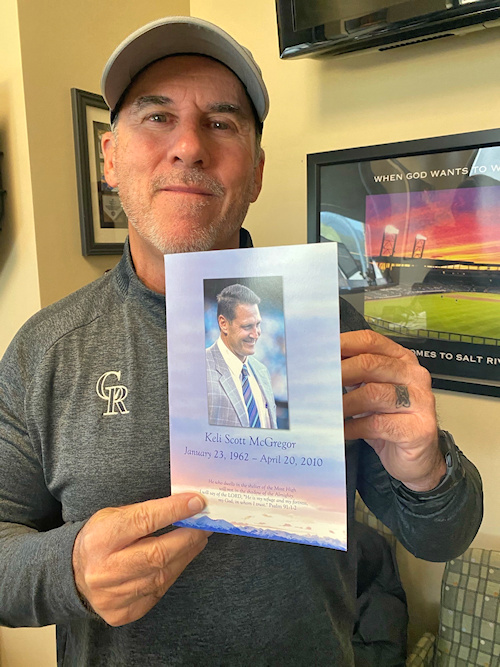 |
| Dave Dunne, GM of Salt River Fields, holds the program from McGregor’s memorial service that’s been on his desk for the past 10 years. CREDIT: BRITTANY DUNNE |
Feasel clearly remembers the shock that swept through the Rockies organization that day. “It was devastating for all of us. It was traumatic. He was in great shape. He worked out every day. He ate healthy. It sent shockwaves throughout our organization and our community.”
Bud Selig was the Commissioner of Baseball at the time. Selig referred to him as “one of our game’s rising stars,” adding that he was “great as a baseball administrator (and) a great human being. All of baseball will miss him.”
Dunne attended the memorial service held in McGregor’s honor at Coors Field five days later. Every day since, the program from that service has been propped up on Dunne’s desk at Salt River Fields. “When I’m having a tough day at the ballpark, I look right at him and say, ‘Keli, what would you do?’”
Today, Tracy calls it his “greatest disappointment” that he didn’t get to spend more time with McGregor. “I can only imagine what it would’ve been like if I would’ve been able to be with him another five years. I felt I got cheated.”
Legacy in structures
Coors Field, the facility that prompted the Rockies to bring McGregor to Denver, is now the third oldest in the National League. Its cleanliness, maintenance and customer service make it still “the standard bearer for many stadiums,” says Monfort. He credits that to McGregor’s involvement in its planning, and the culture he instilled in the organization. “He may not be here to monitor it, but it’s his culture.”
Fans attending Rockies games see “KSM,” McGregor’s initials, on the outfield wall next to the retired numbers of Todd Helton (17) and Jackie Robinson (42). Motivational quotes from McGregor adorn the entrance where gameday employees enter the ballpark.
The Rooftop, a party deck that’s immensely popular with millennials, was constructed in 2014 in Coors Field’s upper deck. “Dick (Monfort) and Keli had gone to a lot of ballparks to see what they wanted to do up there in right field, because if there were any empty seats, that’s where they were,” recalls Lori McGregor, Keli’s widow. “Keli was always really in tune with bringing in young people to cultivate the younger generation of fans.”
There’s no disagreement that Salt River Fields is a significant part of McGregor’s legacy. Dunne, who oversees the operations of the complex, explains that “he had a big influence on the Rockies side and the shared spaces. His handprints are all over here.”
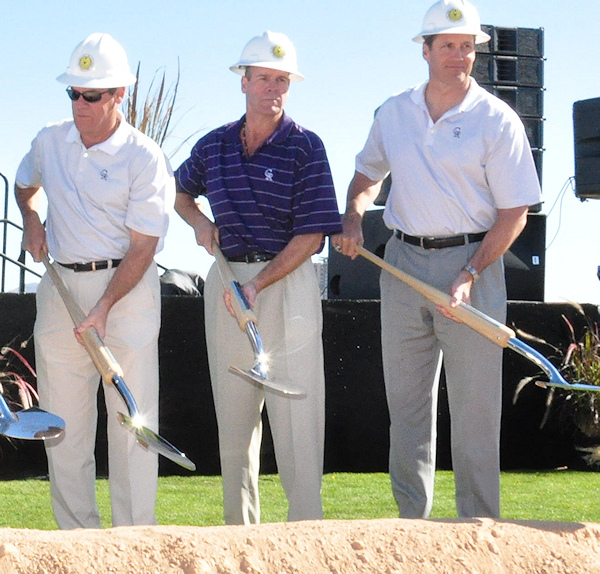 |
| At the groundbreaking ceremony at Salt River Fields in 2009 are Rockies owners Dick Monfort and Charlie Monfort, and on the right is Keli McGregor. CREDIT: SRPMIC |
Since the day the complex opened in 2011 – the year after McGregor passed away – it’s been widely regarded as one of the top facilities in the sport. Indeed, it’s the only spring-training facility to win the BaseballParks.com Ballpark of the Year Award in the two decades of the honor.
Monfort certainly recognizes McGregor’s passion for the complex. “When you put your heart and soul into something, it comes out like Salt River Fields.”
When Hall and McGregor were working with the Salt River Pima-Maricopa Indian Community, which was willing to build the spring-training complex, Hall was struck by his friend’s approach. “He wanted to know as much as he could about the culture and people (of the Indian Community), so he could be as respectful as possible and understand what’s important to them.”
This impressed the leaders of the Indian Community. Bryan Meyers, the Community Manager of the organization, observes that both the Rockies and the Community “have similar values and also value long-lasting relationships. Keli quickly became part of the Salt River Family and therefore, it was very important for our family to honor him and his family in a humble, special way.”
 |
| McGregor’s daughter Taylor stands along the Keli McGregor Reflection Trail on the grounds of Salt River Fields. CREDIT: JOE MOCK |
That way, as it turns out, was their insistence that the Keli McGregor Reflection Trail be constructed along a stream near the home-plate entry of the ballpark at Salt River Fields.
Meyers adds that whenever he attends a game at the park these days, his experience is the same as the way he feels about McGregor: “uplifting and fun. That is a great legacy.”
What Dunne observed during the building of the complex mirrors what those at Rockies’ HQ in Denver experienced. McGregor “treated everybody with a great deal of respect, whether you were the custodian in the construction trailer or another executive.”
In addition to the Reflection Trail, his name is also on the Rockies’ weight room at Salt River. It’s quite appropriate that it’s called the Keli McGregor Fitness Center, as he was a relentless work-out advocate.
“There isn’t a time I go to Salt River when I don’t think of him,” says Courtney. “He and I had been talking about it for years, about the plans and how it was going to be different. Boy, he was right. It’s just a remarkable, beautiful facility.”
And now the latest tribute to McGregor is being constructed in a former surface lot next to Coors Field. The dazzling project that bears his name will remind hotel guests, condo residents and fans streaming toward Rockies games of the lasting impact he made on the sport played in the adjacent ballpark.
Says Lori McGregor of the name McGregor Square, “For Dick (Monfort) to honor Keli like that and leave that legacy for our children, it’s the most humbling thing I could ever imagine.”
Monfort tells the story of an interesting letter that surfaced – 15 years after it was written. As planning on the project was drawing to a close, Executive Assistant Terry Douglass uncovered a letter that McGregor had written. In it, he provided a detailed description of how he felt that site should be developed. “Everything in that letter, to the ‘T’, was exactly what we were doing,” says Monfort. “Keli had envisioned it all 15 years ago.”
“Keli had this way about him where he would say things and they would come to pass,” recalls Lori McGregor. “It’s crazy. Keli had intuition like nobody.”
Legacy in family
McGregor loved talking about his family, and no doubt, he would consider them the most important part of his legacy. And he’d be gratified to know they are all flourishing.
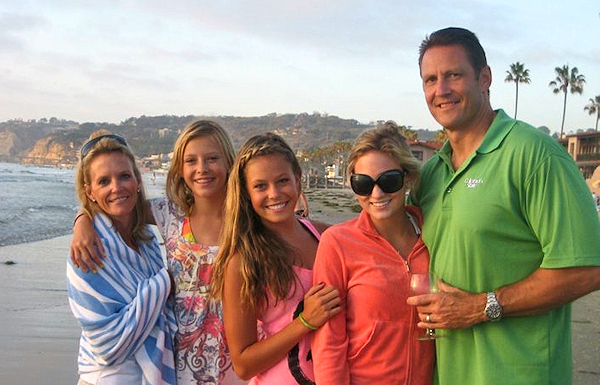 |
| On a family trip to California in 2009 are Lori, Landri, Taylor, Jordan and Keli McGregor. CREDIT: TAYLOR MCGREGOR |
Lori and Keli’s youngest child is Logan, 22. He is about to graduate from the University of Arkansas, and then will join the insurance industry in Dallas. “Logan is a big sports fan,” says his mother, “but he loves playing them more. He’s constantly playing something, whether it’s organized intramurals, or pick-up games with his buddies.”
Daughter Landri is 24. “The overachiever of the group,” is how her mother describes her. She works for Nestle in Washington, DC after graduating at the top of her class in the Business School at Arkansas. She enjoys volunteering in the community.
Well known to Rockies fans is daughter Taylor, 27, as she was the field reporter for the team’s televised games the past two years. When the season starts again, fans in Chicago will enjoy watching her on Marquee Sports Network, which is owned by the Cubs. Like her brother and sister, her alma mater is Arkansas.
Recalling tussles her father had with the media, Taylor wonders what he’d think of her working in television. “He might say to me now, ‘What the heck are you doing?’”
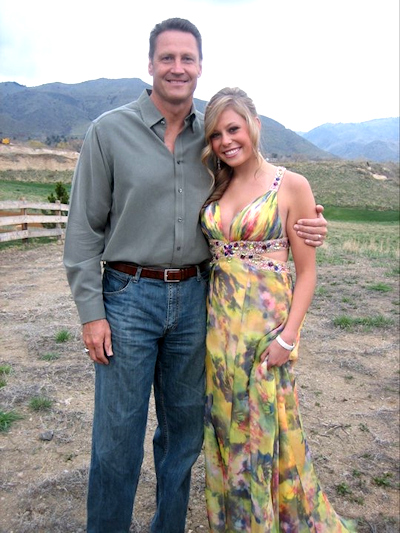 |
| In the last known photo of McGregor, he’s shown here with his daughter Taylor on the day of her Junior Prom in April, 2010. CREDIT: TAYLOR MCGREGOR |
When asked about how she viewed her father’s faith, she says that it “shaped everything. The fact that my dad had the power of the Lord inside him, that’s what allowed him to be the kind of person that he was. He always cared more about other people than about himself.
“The way I carry on my dad’s legacy is to treat everybody with kindness and respect,” she adds. “It doesn’t matter what we (siblings) accomplish. It’s how we treat people that he would care the most about.”
During a recent interview on WGN-AM in Chicago, Taylor was asked about the delay in the baseball season. She replied that while she loves sports and her job reporting on baseball, “it’s not the most important thing. The most important things in my life are my faith and my family.” When Hall was told this, he immediately said, “That was Keli McGregor (talking through her) right there!
“That tells you who Keli and Lori raised,” Hall adds. “Taylor is a perfect example. What a beautiful young lady, carrying on his tradition.”
The couple’s oldest child is daughter Jordan Goergen, 29, of Golden, Colorado. “Jordy got Keli’s very gentle spirit,” says her mother. “She is the sweetest, kindest, most humble girl in the world.” She’s also the mother of the first grandchildren. Her daughter Baylor is two months old and her two-year-old son is named after, you guessed it, his grandfather Keli.
Hurdle says that he has remained close with the McGregor family. “The kids have Keli’s characteristics. I think part of the story of his legacy is his children and what they’re doing.” And regarding what Taylor told the interviewers on WGN, he remarks “When your kids talk that way 10 years after you’re gone, you’ve really had an influence on them.”
Lori explains that what her late husband valued “was people, and doing the right thing and giving back. To the extent that his children are doing that now, that’s what he would be proud of, of the people that they’ve become.”
Lori herself has news, in that she will be getting remarried. She and Greg Alfred of nearby Lakewood, Colorado are planning a wedding for later this year.
And now that Keli’s name and legacy are being mentioned more often because it’s the 10th anniversary of his passing, Lori says, “He was truly a one-of-a-kind guy. All I care about is that people understand that he really was that special.”
Keli was as special as any person I know. The word “special” was made for him. From the day he was hired by the Rockies when I met him, to the day he passed away, Keli treated me the same even though he rose to be president and a really big force within the Rockies baseball club. He was a force and a special friend that will be missed forever.
I’ve known Keli since we were in fourth grade and Slater Elementary in Lakewood. Dear friend through high school. Freshmen roommates at CSU. He had a phenomenal influence on my life. These photos and the story moved me to tears. I miss the man. He loved deeply. God’s richest blessing on Lori and the family, on the lives of all he touched. May we carry forward his legacy during this hard, hard times. I wouldn’t mind hearing him laugh right about now. With his giant frame and soul I might feel for a moment something more solid beneath my feet. But then, he’d point me, as he often did, to the GOD who made it all and say, “All will be well.” So let us live his legacy. Be well. Be kind. And remember, we can do hard things.
What a thoughtful, well-written article!
Keli was truly a great friend and brother in the Lord. Keli, Joe Coors Jr. and Shawn Caldwell were the driving force in helping start a Bible Study over 16 years ago at Bandimere Speedway. This study continues today with many coming to a life-changing relationship with Jesus. Keli was always early and sat in the same location with a Venti Starbucks in each hand! Kelli’s size was daunting but the gentle spirit he possessed made him a joy to be around. I thank God for allowing Keli to be a part of my life and spiritual growth!